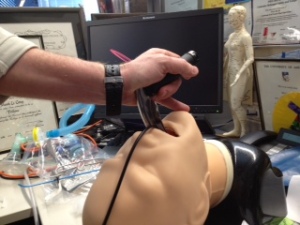 I am on a journey of discovery and experimentation in laryngoscopy. I am in search of the sub $100 disposable video laryngoscope. I found one earlier this year. Its called the Vividtrac AT-100. Its like an AirTraq only smaller but has a USB cable to plug into a laptop and power the LED for the camera. I bought some to test at a cost of $65 AU each.
I am on a journey of discovery and experimentation in laryngoscopy. I am in search of the sub $100 disposable video laryngoscope. I found one earlier this year. Its called the Vividtrac AT-100. Its like an AirTraq only smaller but has a USB cable to plug into a laptop and power the LED for the camera. I bought some to test at a cost of $65 AU each.
I got our resident Master Airway practitioner, Dr Jim DuCanto to provide some feedback from his test lab. Here is his video recorded testing.
I have had similar feedback and comments from doctors during my airway courses and almost all have stated a preference for the King Vision Video Laryngoscope compared with the Vividtrac. However I have had one aeromedical retrieval physician who has taken a liking to the Vividtrac and has had positive feedback during training with paramedics he works with.
So my search continued and what I quickly realised was that almost all doctors I spoke to preferred using the traditional Macintosh blade laryngoscope and any different device designs like Airtraq, Vividtrac or King Vision are somewhat too radical a departure from their traditional direct laryngoscopy skills to be taken up enthusiastically.
Now there are video laryngoscopes on the market currently that offer traditional style Macintosh blade designs. The most popular systems would be the CMAC ( Karl Storz) and McGrath. Glidescope system does not have a truly Macintosh style blade. NONE OF THEM COST LESS THAN $2000 AU, let alone $100.
SO WHAT TO DO?
Build it yourself? Why not?
What do you need?
1.Macintosh blade laryngoscope #4, disposable. I chose the Trulite version, fully disposable, $16.
2.USB waterproof endoscope, $27.
3. Windows or Apple OS laptop/tablet with USB port, use Vividtrac imaging software to display USB camera image
TOTAL COST (exc laptop) = $42
Its waterproof as I demonstrate it here in a glass of water, imaging a Mallinckrodt ETT next to the glass.
But I quickly realised once again, did you really need a Macintosh blade? Would a spoon bent into the curve of a Mac blade be sufficient? YES IT WOULD!
A NOTE OF CAUTION!
The system described is a working proof of concept model. It utilises off the shelf, current materials and items. The USB endoscope is not medically licensed as a clinical device for endoscopy. What I have demonstrated is for experimental and research development only, not for clinical use at the moment. My vision is to develop a medical device licenced kit to convert your existing MAcintosh style laryngoscopes into video laryngoscope capabilities, with each kit being fully disposable at low cost , sub $100. Also I envisage a disposable , cheap Macintosh laryngoscope with the USB endoscope already built in, sub $100 each.
I HAVE A DREAM. Today the dream got one step closer to reality! If you beat me to develop and market this commercially, that would be fantastic as I then get to buy a commercial licensed sub$100 Macintosh type VL system. If I beat all of you to develop and market this concept commercially, then good for me because my dream will have been REALISED!

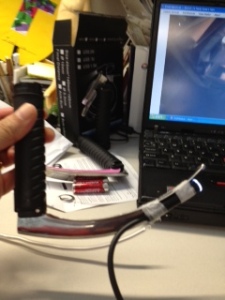
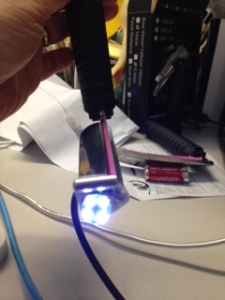
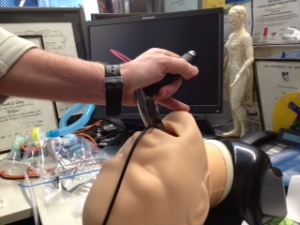
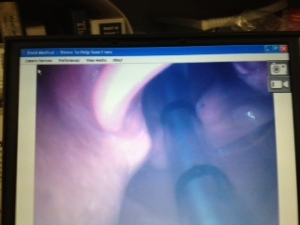
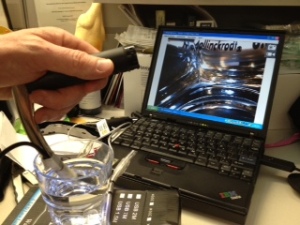
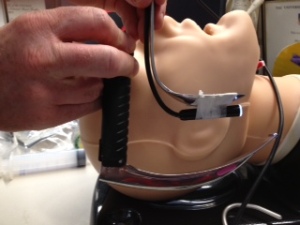
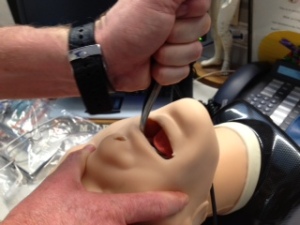
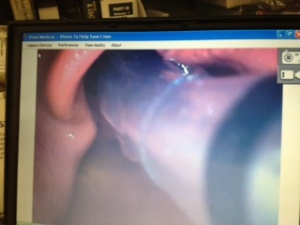
http://www.kickstarter.com/
Brilliant! Couple this with a Raspberry Pi microcomputer ($35) and a 7″ LCD screen (~$150-200), you could have a portable version which wouldn’t require a laptop at around $300. You could use Android tablets, however, the out-of-the-box version of their Linux kernel does not support USB webcams; which would limit non-software folks from utilizing them.
Better yet would be getting the cardiac monitor companies involved with a set of peripherals like video laryngoscopy and ultrasound. Picture-in-Picture VL attempts next to their vitals!
This is the way to go, I reckon…
A monitor integrated onto usual anaesthetic machine setup, or detachable for use elsewhere
Ability to record intubation, for teaching/taining/audit purposes
Simple video in cable from laryngoscope to monitor
Simple laryngoscope, preferable Mac blade with/without channel
IPad or similar integration would be wild.
Good on you Minh for thinking of this. If looking for investors, I’ll bung in some $$$
Whatever, these are the innovations that will matter.
Just dont forget ability to record video – I reckon the feedback for both teacher and student is invaluable, especially for the first 100 intubations or so when acquiring skills…
looks awesome. Want to build one of my own.
Thanks so much for the tip, Dr. LeCong! I’m planning on using this for educating paramedics and clinical students in intubation. It works amazingly well, and I think they will get a great first hand view of laryngoscopy through it.
On a related subject, has anyone used these with Apple products? How do they work with iPad/iPod and an adaptor?
Once again, thanks for a great teaching tool!
thanks Dan! I did test an Apple USB adapter to connect digital cameras with this USB endoscope setup. It failed to work because the power needed to be drawn from the Ipad to make the USB endoscope work, was too high for the system, so the endoscope did not even light up.
I think thats going to be a limiting factor for such a cheap setup.
I aim to test it on a windows based tablet with a USB port and will post my findings. theoretically should work!
I reckon those new SD eye-fi cards might be the way ahead…
Pop one into the scope
Then wirelessly stream to laptop/iPad/iPhone etc
Also a switch to activate AND record would serve as a great ‘proof’ in case of coroners
So, from bottom up, you need
– traditional mac blade
– video screen on scope in cae no output device
– No messy wires/cables .. i have enough problems with the tangle fairy already
– SD card to stream via eye-fi to PC/Mac/iPad/android/smartphone
– SD card to store images for teaching and audit
It is do-able…
Dr. Le Cong,
I found my way to your site via an EMCrit podcast.
Did you ever find a suitable sub $100 videolaryngoscope?
Your idea of making your own is great- now Im looking for a small, cheap tablet with USB.
These would be fantastic for our rural EMS service. We have seen transport times of cardiac arrest patients over 40 minutes. Having a cheap videolaryngoscope on board for the difficult ETI’s would be a huge improvement.
Im glad I found your site- lots of great info here!
Hi Will
thanks for the feedback!
I have discovered a sub $100 disposable VL system!
Its called the Vividtrac AT 100 USB powered VL ( I have no disclosures with the makers). It costs $70 ea, disposable.
I use my daughter’s old ASUS EEE netbook as the monitor. Both fit in my retrieval kit bag fine, weight is not an issue.
the LED light on it is awesome and the picture quality v good for the price.
Now one thing is that it is not MAC bladed VL..its more like an Airtraq, Pentax AWS, or King Vision. It uses a guide channel to deliver the ETT. If you train with it, and get used to it, it works well. And all for less than $100!
And come Mid 2013 it goes wireless to your ipHOne!
Hi Minh,
I just got my vividtrac device with a nexus 7 that has the vividvision application. Anyway, I tried connecting a usb powered inspection camera to the nexus 7 by using an otg cable…lo and behold…it works. So by pairing the a usb endoscope with ordinary mac blade and using the nexus 7 as your monitor you can get a videolaryngoscope experience akin to a Cmac. The use of a nexus 7 makes it very handy especially for you guys in retrieval and prehospital medicine.
well donee! thanks for the news!
Nexus 7 is the device then! for now!
…hang in, how about us Mac FanBois (n girlz)?
Will it work with iPad or iPhone? Given the proclivity of Mac devices amongst propellor-head gas docs, I think this needs urgent attention
Otherwise Steve Jobs will frown down from the iCloud and smite you all….
in the search for the VL for the masses, one must become device agnostic.
such is the path to airway enlightenment
Hello
I picked up Your idea, took a ordinary Mac 3-blade, pulled out the fibers and inserted a 5 mm
endoscope cam manufactured by DNT. Camera was adjusted for triple ‘t’ i.e. tip-target-tube by a tiny screw. To booster the LEDs I inserted 4x 3.6 V Lithium batteries which gives a very bright light. The assisting nurse holds the handheld monitor.
To avoid fogging of the cam I switch on the device 5 min before intubation.
O.K. this device is no match for a storz c-mac of which I own 2 – but costs less than 1/50 of the storz.
awesome work! Can you email some pictures of the device for posting please?
Hi,
I’m just curious as to what kind of monitor did you use? The endoscope I worked with works also with a macbook. I got a new industrial endoscope (5.5mm diameter) and would try to pair it with a hyperangulated blade made through 3D printing. Will post pics once I got it working.
Look forward to the pics!
I’ve thought of doing this, but wondered how on earth you sterilize the endoscope appropriately to be able to reuse it – or are you targeting single use only?
Single use
Are you still looking for a disposable Mac blade type sub $100 video laryngoscopy system? What about the I view scope, https://www.medistock.co.uk/products/portable-disposable-low-cost-lightweight-video-laryngoscope-i-view-lcd-screen-single-unit.
I am looking for something cheaper that doesn’t require a smartphone for the third world country.
Yes that is an option now but some folks have found it not as good video quality as devices like CMAC or Glidescope . I guess you get what you pay for !
Hi Minh,
Do you have a private email? I am a Vietnamese American Anesthesiologist in private practice in California for 19 years who has recently started going on medical missions to Vietnam. I’m interested in developing a cheap option for video laryngoscopy for Vietnam (and the third world). The people that I work with have used the borescope with cellphone as an intubating stylet with great success. The video quality is actually quite good. There is currently a borescope with it’s own detachable monitor that sells for $30 on Amazon. It only requires a portable power source (readily available for cellphone and is subsequently completely portable. Send me your email and I will send you the link along with the intubation video as recorded by the borescope.
For the group, I would like to ask if the I View laryngoscope video quality is the same as the borescope with the cellphone? The video quality of the borescope is actually quite good.
Hi Craig
Yes you can contact me via mlecong@gmail.com
There are also wireless cameras that are small enough to secure to a laryngoscope blade and send the video feed to a phone app . They run off a small lithium battery attached to the wifi module of the camera .
The iview video quality is average , inferior to CMAC and Glidescope . One colleague found the video quality inadequate during intubation of soiled airway